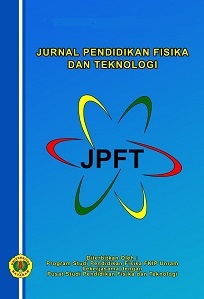Pengaruh Model Pembelajaran Berbasis Masalah Berbantuan Simulation Based Laboratory (SBL) Terhadap Hasil Belajar Fisika Peserta Didik Kelas XI IPA SMAN 1 Montong Gading
DOI:
10.29303/jpft.v4i1.542Published:
2018-05-28Issue:
Vol. 4 No. 1 (2018): Januari - Juni 2018Keywords:
Problem-Based Learning, Simulation Based Laboratory, Learning outcomeArticles
Downloads
How to Cite
Downloads
Metrics
Abstract
This research is aimed to know the influence of Problem-Based Learning Models assisted with Simulation Based Laboratory (SBL) on studentsââ¬â¢ physics learning outcome in class XI IPA of SMAN 1 Montong Gading academic year 2015/2016. The material used in the research is momentum and impulses. The type of the research is quasi experiment with pretest-posttest control group design. The population which is used in this research are the whole students of class XI IPA of SMAN 1 Montong Gading which decided by purposive sampling technique. C lass XI IPA 1 as the experiment class and class XI IPA 2 as the control class. The result of study was analized using t-test polled varians. Based on the research outcome, it can be concluded that Problem-Based Learning Models Assisted with Simulation Based Laboratory (SBL) influenced students` physics learning outcome.References
Abidin, Y. 2014. Desain Sistem Pembelajaran Dalam Konteks Kurikulum 2013. Bandung: PT Refika Adiatama.
Arikunto, S. 2010. Prosedur Penelitian. Jakarta: Rineka Cipta.
________. 2012. Dasar-dasar Evaluasi Pendidikan Edisi Revisi. Jakarta: Bumi Aksara.
Fahrizal, E., Sar, S. & Parmi, S. 2013. Problem Based Learning Dalam Pembelajaran Fisika Menggunakan Simulation Based Laboratory (SBL) Dan Video Based Laboratory (VBL). Jurnal materi dan pembelajaran Fisika, 2, 25-36.
Gunawan, G., Sahidu, H., Harjono, A., & Suranti, N. M. Y. The Effect of Project Based Learning with Virtual Media Assistance on Student's Creativity in Physics. Cakrawala Pendidikan, (2), 167-179.
Herayanti, L, & Habibi. 2015. Model Pembelajaran Berbasis masalah Berbantuan Simulasi Komputer untuk Meningkatkan Keterampilan Berfikir Kritis Calon Guru Fisikaââ¬Â. Jurnal pendidikan Fisika dan Teknologi, 1(1), 61-66.
Heinich, Robert. 2005. Instructional Technology and Media for Learning. Ohio: Merill Prentice Hall.
Hikmawati, & Gunada, I. W. 2013. Kajian Fisika SMA. Mataram: FKIP Universitas Mataram.
Huda, M. 2013. Model-Model Pengajaran dan Pembelajaran Isu-isu Metodis dan Pragmatis. Yogyakarta: Pustaka Pelajar.
Jauhari, T., Hikmawati, & Wahyudi. 2016. Pengaruh Model Pembelajaran Berbasis Masalah Berbantuan Media Phet Terhadap Hasil Belajar Fisika Peserta didik Kelas X SMAN 1 Gunungsari Tahun Pelajaran 2015/2016. Jurnal Pendidikan Fisika dan Teknologi, 2(1), 7-12.
Rusman. 2010. Model-model Pembelajaran Mengembangan Profesionalisme Guru. Jakarta: PT Rajagrafindo Persada
________. 2015. Statistika untuk Penelitian. Bandung: Alfabeta.
Susanto, D., Sutrio & Wahyudi 2015. Pengaruh Pembelajaran Berbasis Masalah Melalui Metode Eksperimen Terhadap Keterampilan Proses Sains Fisika Peserta didik SMA Negeri 1 Selong Tahun Ajaran 2014/2015. Jurnal Pendidikan Fisika dan Teknologi, 1(3), 160-165.
Wahyuni, S & Widiarti, N. 2010. Penerapan Pembelajaran Berbasis Masalah Berorientasi Chemo-Entrepreneurship Pada Praktikum Kimia Fisika. Jurnal Inovasi Pendidikan Kimia, 4(1), 484-496.
License
Authors who publish with Jurnal Pendidikan Fisika dan Teknologi (JPFT) agree to the following terms:
- Authors retain copyright and grant the journal right of first publication with the work simultaneously licensed under a Creative Commons Attribution License 4.0 International License (CC-BY-SA License). This license allows authors to use all articles, data sets, graphics, and appendices in data mining applications, search engines, web sites, blogs, and other platforms by providing an appropriate reference. The journal allows the author(s) to hold the copyright without restrictions and will retain publishing rights without restrictions.
- Authors are able to enter into separate, additional contractual arrangements for the non-exclusive distribution of the journal's published version of the work (e.g., post it to an institutional repository or publish it in a book), with an acknowledgement of its initial publication in Jurnal Pendidikan Fisika dan Teknologi (JPFT).
- Authors are permitted and encouraged to post their work online (e.g., in institutional repositories or on their website) prior to and during the submission process, as it can lead to productive exchanges, as well as earlier and greater citation of published work (See The Effect of Open Access).











